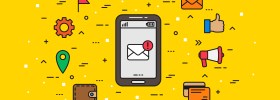By Ariane van de Ven (@ariane_vdv), Global Trends Expert, Telefonica

19 December 2013: I’ve been identifying consumer trends for Telefónica since 2009, and at the end of each year – a time of reflection and projection – I roll out a trends report. Here, I’m revisiting here some of the trends I’ve identified in the past and also sharing new forecasts for 2014.
I organise my research according to 3 dimensions: individual, society and technology.
The trends we’re sharing here are representative of mindsets and you will find that some are in direct opposition with each other. This is because as human beings, we are complex and multi-faceted individuals, and not all our actions and behaviours always coincide!
In past trend reports, I explained how technology is fundamentally transforming our lifestyles, enabling us to feel hyper-connected (see Always-on trend) and providing us with an abundance of information and choices.
Increasingly, speed and the quantity of work are becoming measures of intelligence! Some people find these changes overwhelming – their stress levels are rising as they strive to keep up with the pace of the digital age. Others see the bigger picture and surrender to the fact that in this new context, being an ordinary person is not enough.
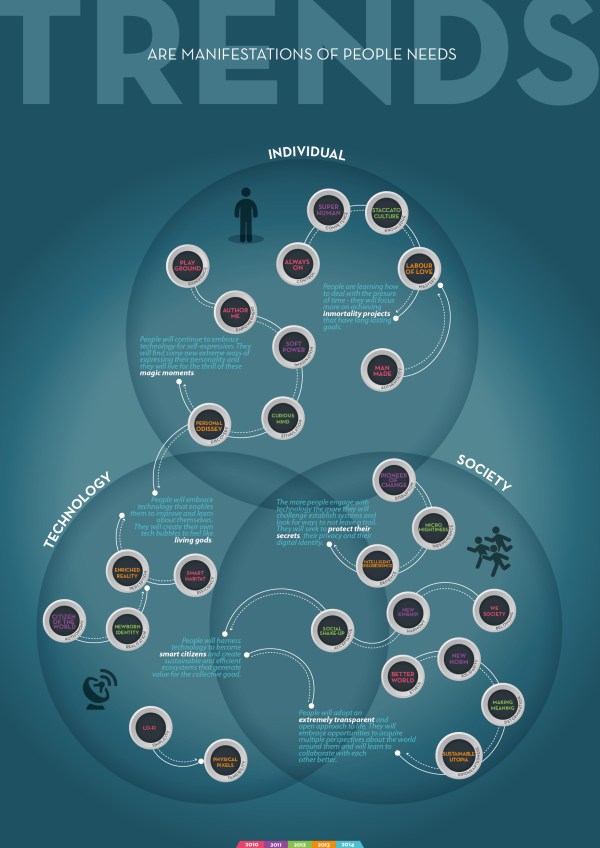
They leverage digital technology to excel and create new opportunities for themselves (see Superhuman trend). Similarly, the Specialists I described in the Labour of Love trend (see here) design strategies to differentiate themselves in order to stand out and succeed. They focus on very few carefully selected niche topics they can contribute to and ‘master’.
I predict that some people will actively seek to bring more focus into their lives and the choices that they make. Focus is important as many studies find that human beings cannot do more than one thing at the time well. Instead of competing with technology’s pace, people will embrace their human characteristics and limitations.
Trend Map One
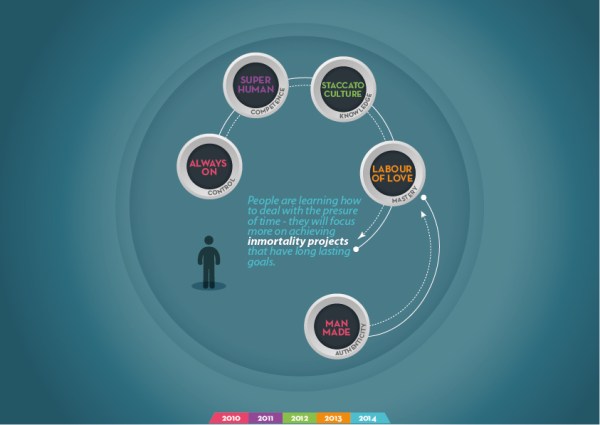
I also explained that people increasingly use technology to express themselves and to embrace their imagination (see Soft Power trend).
The success of Tumblr, Pinterest and Instagram are clear indications that self-expression and also creative stimulation are important sources of inspiration for people. The Explorers I described in the last report (see Personal Odyssey trend) use technology to discover more about themselves and the world around them. Thanks to geo-location and augmented reality services they find new opportunities for self-exploration and discovery.
I predict that in the future, some people will become restless when it comes to exploring their potential. They will seek to be exposed to chaotic and extreme situations in order to learn about themselves. There will be a dichotomy between the fact that people are trying to make their lives comfortable and safe; and the fact that they will also want to expose themselves to extreme risks in order to feel challenged and get a sense of ‘rush’. These people will be sensation seeking. By experiencing extreme sensations they will feel that they live their life to the fullest. The adrenaline rush of these ‘magic moments’ will make them feel alive and they will become addicted to this extreme feeling.
Trend Map Two
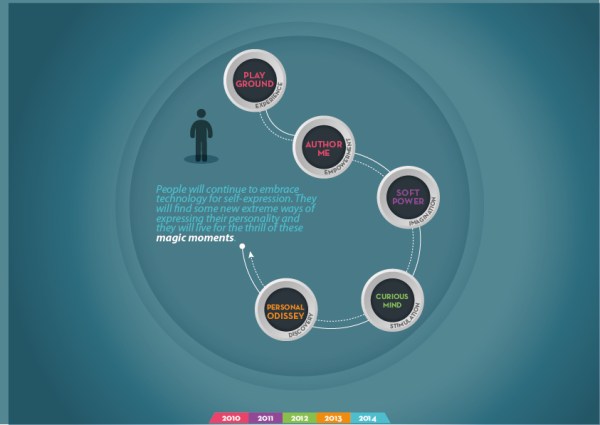
Within the group dimension, people and organisations are realising they are better together. Collaborating, sharing, building things together and relating to one another is changing the dynamics of society and decentralizing power.
In the past reports, I explained that people and organisations are becoming more concerned with Sustainability (Better World trend). They aspire to a more efficient management of resources, leveraging M2M technology and the Internet of things to make positive changes (New Norm trend). Additionally, people and organisations have continued to commit to the improvement of their own wellbeing and the one of the planet. Digital technology enables them to share instead of purchase things and also to automate tasks so that they can spend time doing things that are truly meaningful to them. The Utopians I described in the last trend report (Sustainable Utopia trend) want to collaborate with each other regardless of where they might be in the world, to create positive and systemic change.
I predict that digital technology will bring more transparency and openness to people’s mindset and behaviours. Indeed, research shows that people are increasingly considering themselves as world citizen as opposed to national citizen. Digital is transforming people’ sense of identity and people are becoming more open and multidimensional. As a result, some people will relate to a global conscience and will desire to collectively create and contribute to systems that are good for the community in the long-term.
Trend Map Three
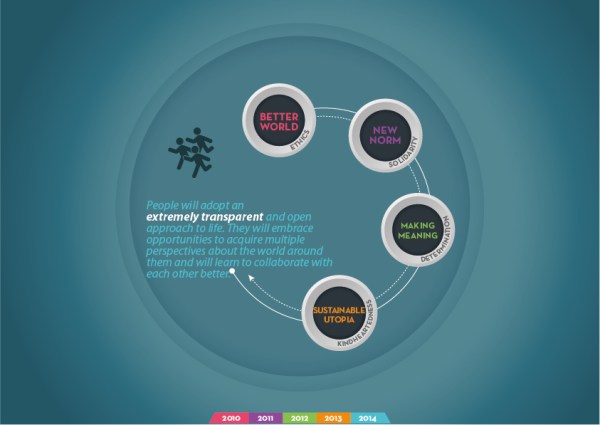
I also explained that people are feeling increasingly empowered to impact the world around them thanks to technology.
Indeed, people identify with the whole world and have the know-how to bring about innovation and change at a local level (Pioneer of Change trend). People also harness digital technology to start projects independently and grow them on a global scale. The democratization of technology provides tools for people to create the change they want to see in the world. It gives them a sense of power. In the last report, I described the Solvers (Intelligent Disobedience trend) as individuals and groups who are defying the established systems and proposing alternative solutions. As digital users become more mature and savvy, they are realising that governments have picked up on their digital trail and identity. Additionally, the datafication of the world whereby anything can now be turned into a quantifiable format exposes people and their behaviours whether they like it or not.
I predict that people will continue to harness digital technology as a source of empowerment but for some, as their digital contributions grow, they will become more cautious. They will attempt to contribute anonymously and they will demand that new laws are created to protect their secrets, their privacy and their digital identity.
Trend Map Four
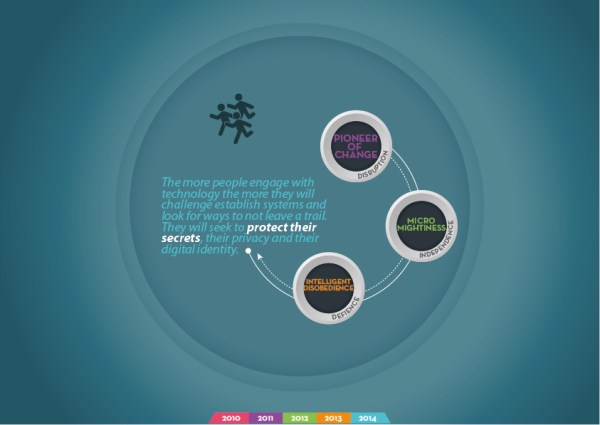
Within the technology dimension, I identify emerging behaviours that are happening thanks to the use of technology.
The more people use technology, the more it provides them with truly personalised and meaningful experiences. As a result people depend more on technology but they also harness and leverage its potential in order to transform themselves and the world around them.
I previously mentioned that technology enables people to discover more about themselves (Personal Odyssey trend). Thanks to technology people can automate tasks, monitor their activity and anticipate potential outcomes (Smart Habitat trend). Technology also enhances their experience within a given environment, providing them with more information and context so that they can become the Perceivers I described in the last trend report. Technology will continue to develop in this space, enabling people in many new ways to create their own personal tech bubbles. This is exciting because it shows that people integrate more technology into every aspect of their lives to enhance themselves, and also to reflect, reminisce, compete, challenge and inspire themselves. In a context of turmoil and constant change, it is not surprising that individuals chose to focus on themselves and adopt a self-centred attitude. This is a common survival strategy.
I predict that with more intense global competition for employment, an ageing population, and solo living rising, individuals will spend more time thinking about themselves first. As a result, more people will use technology that offers personal benefits and that can make them feel like living gods. People will look for services that enable them to know themselves better and to surpass themselves.
Trend Map Five

Finally, in the last trend report, I introduced the Utopians: people who are experimenting with new systems to create more sustainable living alternatives (Sustainable Utopia). Indeed, as digital technology creates more transparency it motivates people to create systemic change for the collective good (Better World, New Norm, Making Meaning). Additionally, people harness digital technology to collaborate better and form groups that can create new communities and positive change.
I predict that increasingly technology will impact people’s outlook and instead of thinking in terms of isolated issues or to focus on the wellbeing of their own community, people will realise that most things are interconnected. People will think on a much bigger scale and will look for ways to impact the globally connected society. They will realise that thanks to technological progress they are now able to realise their ideas. People and groups will want to add value to systems instead of extracting personal value from them. They will aspire to contribute collectively to the greater good. They will harness technology to elaborate ecosystems that can fundamentally improve living standards, thanks to technology.
Trend Map Six
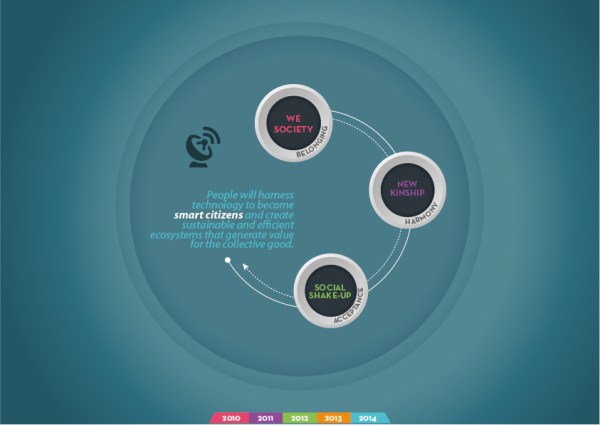


![[Radar7 X’mas Special] What were the seven most futuristic gadgets of 2013?](https://en.blogthinkbig.com/wp-content/uploads/sites/5/2014/05/shutterstock_169002578.jpg?resize=p%2Co)
![[Roundup] 10 Tech Influencers on Openness in Innovation](https://en.blogthinkbig.com/wp-content/uploads/sites/5/2014/01/shutterstock_126023273.jpg?resize=p%2Co)
